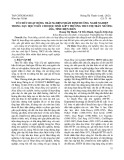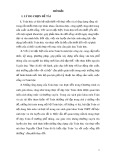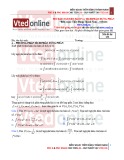Arranging numbers on circles to reach maximum total variations
Ying-Jie Liao
Shi-Chun Tsai
Min-Zheng Shieh Department of Computer Science
National Chiao Tung University, Hsinchu 30050, Taiwan
fyjliao,mzhsieh,sctsaig@csie.nctu.edu.tw
Submitted: Jan 15, 2007; Accepted: Jun 10, 2007; Published: Jun 28, 2007 Mathematics Subject Classi(cid:12)cation: 05A05, 05B30
Abstract
The dartboard problem is to arrange n numbers on a circle to obtain maximum risk, which is the sum of the q-th power of the absolute di(cid:11)erences of adjacent numbers, for q (cid:21) 1. Curtis showed that the dartboard problem admits a greedy algorithm. We generalize the dartboard problem by considering more circles and the goal is to arrange kn number on k circles to obtain the maximum risk. In this paper, we characterize an optimal arrangement for k = 2 and show that the generalized dartboard problem also admits a greedy algorithm.
1 Introduction
n i=1 j(cid:11)i (cid:0) (cid:11)i(cid:0)1jq where (cid:11)0 (cid:17) (cid:11)n and q (cid:21) 1.
Darts is a very popular game. Players throw darts and score points corresponding to the sector the darts just landed on. The traditional dartboard is circular and partitioned into several sectors as shown in (cid:12)gure 1. When playing darts, players often aim at the high score sectors. But for ordinary players, it is hard to land the dart on the desired sectors. The risk of aiming at an area can be measured by the di(cid:11)erence between the scores of adjacent sectors. As the larger the di(cid:11)erence is, the higher the risk is and the game becomes more challenging. The total risk of a dartboard is the sum over the risks of all sectors. The so called dartboard problem, as discussed in Curtis’ paper [4], is to (cid:12)nd a cyclic permutation (cid:28) = (cid:11)1 (cid:1) (cid:1) (cid:1) (cid:11)n of a multiset fa1; (cid:1) (cid:1) (cid:1) ; ang on a circle which maximizes the risk function P
the electronic journal of combinatorics 14 (2007), #R47
1
The dartboard problem has been studied for a while. Eiselt and Laporte [5] used a branch-and-bound algorithm[1] to (cid:12)nd optimal permutations for the dartboard problem on f1; 2; : : : ; 20g for q = 1 and q = 2, and they observed that the traditional dartboard score arrangement is not optimal. Chao and Liang [2] studied the permutations of n distinct numbers arranged on a circle or a line and showed the arrangements that maximize or
20 5 1 12 18 9 4
14 13
11 6
10 8
16 15
7 2 19 17 3
Figure 1: A traditional dartboard.
n
n
i=1 jvi (cid:0) wijq + P
n
minimize the risk function. Later, Cohen and Tonkes [3] analyzed optimal permutations for multisets of numbers. Recently, Curtis[4] designed a greedy algorithm to (cid:12)nd an optimal permutation (cid:25) = a1an(cid:0)1a3an(cid:0)3a5 (cid:1) (cid:1) (cid:1) an(cid:0)4a4an(cid:0)2a2an for the dartboard problem, where a1 (cid:20) a2 (cid:20) (cid:1) (cid:1) (cid:1) (cid:20) an.
n
In this paper, we extend the dartboard problem from single circle to double circles. For example, the dartboard with two circles, is as shown in (cid:12)gure 2. Assume that we are given a multiset of 2n numbers and a double layer dartboard. We use a pair of permutations (v1 (cid:1) (cid:1) (cid:1) vn; w1 (cid:1) (cid:1) (cid:1) wn) to describe the arrangement, as shown in (cid:12)gure 3, where v1 (cid:1) (cid:1) (cid:1) vn is a cyclic permutation for the outer circle and w1 (cid:1) (cid:1) (cid:1) wn is a cyclic permutation for the inner circle. We can extend the de(cid:12)nition of the risk function to the double layer dartboard. For example, the risk of the arrangement (v1 (cid:1) (cid:1) (cid:1) vn; w1 (cid:1) (cid:1) (cid:1) wn) in (cid:12)gure i=1 jvi (cid:0) vi(cid:0)1jq + 3, denoted by rq(v1 (cid:1) (cid:1) (cid:1) vn; w1 (cid:1) (cid:1) (cid:1) wn), is de(cid:12)ned as P i=1 jwi (cid:0) wi(cid:0)1jq where v0 (cid:17) vn and w0 (cid:17) wn. We de(cid:12)ne the 2-dartboard problem as: P (cid:12)nding an arrangement ((cid:28)V ; (cid:28)W ) for a multiset A = fa1; (cid:1) (cid:1) (cid:1) ; a2ng on two circles which maximizes the risk function, where V and W is a partition of A and both have n elements. Furthermore, we can extend the dartboard problem to k-layer dartboard. We use k cyclic permutations ((cid:28)1; (cid:1) (cid:1) (cid:1) ; (cid:28)k) to represents the arrangement where (cid:28)i is a permutation on n elements for the i-th circle. The risk function can be recursively de(cid:12)ned as
rq((cid:28)1; (cid:1) (cid:1) (cid:1) ; (cid:28)k(cid:0)2; (cid:28)k(cid:0)1 = v1 (cid:1) (cid:1) (cid:1) vn; (cid:28)k = w1 (cid:1) (cid:1) (cid:1) wn) = rq((cid:28)1; (cid:1) (cid:1) (cid:1) ; (cid:28)k(cid:0)1) + rq((cid:28)k) + jvi (cid:0) wijq ; X i=1
where the last term is the sum over the q-th power of the absolute di(cid:11)erences between numbers of the (k (cid:0) 1)-th and k-th circles. Similarly, the k-dartboard problem is: (cid:12)nd- ing an arrangement for a multiset A = fa1; (cid:1) (cid:1) (cid:1) ; akng on k circles to maximize the risk function.
the electronic journal of combinatorics 14 (2007), #R47
2
For the k-dartboard problem, we show once the numbers on each circle is determined, then we can (cid:12)nd the maximum arrangement e(cid:14)ciently. Moreover, we show that for the 2-dartboard problem, there exists an e(cid:14)cient greedy algorithm given an arbitrary input.
40
3
2
36
37
1
39
38
7
6
4
5
32
33
11
10
28
29
35 8 31 12 27
34 9 30 13 26
17
16
15
14
23
22 20
24
25
18
19 21
vn
vn(cid:0)1
v1
wn
wn(cid:0)1
w1
v2
vn(cid:0)2
w2
wn(cid:0)2
w3
wn(cid:0)3
vn(cid:0)3
v3
(cid:1) (cid:1) (cid:1) (cid:1) (cid:1) (cid:1) (cid:1) (cid:1) (cid:1)
(cid:1) (cid:1) (cid:1) (cid:1) (cid:1) (cid:1) (cid:1) (cid:1) (cid:1)
Figure 2: A double layer dartboard
Figure 3: An arrangement for double layer dartboard
However, it is not clear whether there exist an e(cid:14)cient algorithm for the k-dartboard problem (k > 2) when the input does not specify the numbers on each circle. We leave it as an open question.
2 Preliminaries
The following lemma is very useful in our proof, which was proved in Curtis’ paper[4].
Lemma 1. [4] Let lmin; lmax; rmin; rmax; q be real numbers with q (cid:21) 1: If lmin (cid:20) lmax and rmin (cid:20) rmax, then jlmax (cid:0) rminjq + jlmin (cid:0) rmaxjq (cid:21) jlmax (cid:0) rmaxjq + jlmin (cid:0) rminjq.
With lemma 1, Curtis[4] proved the following theorem:
the electronic journal of combinatorics 14 (2007), #R47
3
Theorem 1. [4] For arranging n numbers a1 (cid:20) a2 (cid:20) (cid:1) (cid:1) (cid:1) (cid:20) an on a single circle dartboard, the permutation a1an(cid:0)1a3an(cid:0)3a5 (cid:1) (cid:1) (cid:1) an(cid:0)4a4an(cid:0)2a2an maximizes the risk function.
n
For an n-element multiset A, we denote the maximum permutation of A claimed in Theorem 1 by (cid:25)n(A). Cyclic permutations are reverse-invariant and shift-invariant when calculating the risk function. That is, the value of risk is the same under the following permutations (cid:11)1 (cid:1) (cid:1) (cid:1) (cid:11)n, (cid:11)n (cid:1) (cid:1) (cid:1) (cid:11)1 and (cid:11)i+1 (cid:1) (cid:1) (cid:1) (cid:11)n(cid:11)1 (cid:1) (cid:1) (cid:1) (cid:11)i for i 2 [n (cid:0) 1]. We denote the reverse of permutation (cid:28) by (cid:28) R.
n
i=1 jxi (cid:0) yn(cid:0)i+1jq Proof. Assume that y1; (cid:1) (cid:1) (cid:1) ; yn are not sorted in increasing order and P is maximized. Thus, there exists i; j such that i < j and yn(cid:0)i+1 < yn(cid:0)j+1. We call i and j form an inversion in yi’s . As xi (cid:20) xj, we know that jxi (cid:0) yn(cid:0)i+1jq + jxj (cid:0) yn(cid:0)j+1jq (cid:20) jxj (cid:0) yn(cid:0)i+1jq + jxi (cid:0) yn(cid:0)j+1jq by lemma 1. Therefore the sum does not decrease after swapping yn(cid:0)i+1 and yn(cid:0)j+1. By repeating the swapping step whenever there is an inver- sion in yi’s, then we can eventually rearrange yi’s in increasing order without decreasing the sum, since there are at most O(n2) inversions in a permutation of size n. 2
Lemma 2. Given two multisets of numbers X = fx1; (cid:1) (cid:1) (cid:1) ; xng and Y = fy1; (cid:1) (cid:1) (cid:1) ; yng. i=1 jxi (cid:0) yn(cid:0)i+1jq has the maximum Assume that x1 (cid:20) (cid:1) (cid:1) (cid:1) (cid:20) xn. If y1 (cid:20) (cid:1) (cid:1) (cid:1) (cid:20) yn, then P value over all possible permutations of yi’s, where q (cid:21) 1.
With lemma 2, we have the following theorem.
Theorem 2. If n numbers on each circle are given, say X and Y are the multisets of numbers on the outer circle and the inner circle, respectively, then the arrangement ((cid:25)n(X); (cid:25)n(Y )R), achieves the maximum risk. That is, rq((cid:25)n(X); (cid:25)n(Y )R) (cid:21) rq((cid:28)X; (cid:28)Y ) for any permutation (cid:28)X of X and (cid:28)Y of Y .
Proof. Since the numbers on the outer circle are permuted with (cid:25)n(X), the risk con- tributed from the outer circle is maximized and so is (cid:25)n(Y )R to the inner circle. Assume X = fx1; (cid:1) (cid:1) (cid:1) ; xng with x1 (cid:20) (cid:1) (cid:1) (cid:1) (cid:20) xn and Y = fy1; (cid:1) (cid:1) (cid:1) ; yng with y1 (cid:20) (cid:1) (cid:1) (cid:1) (cid:20) yn. Observe that (cid:25)n(X) = x1xn(cid:0)1x3 (cid:1) (cid:1) (cid:1) xn(cid:0)2x2xn and (cid:25)n(Y )R = yny2yn(cid:0)2 (cid:1) (cid:1) (cid:1) y3yn(cid:0)1y1. By lemma 2, we have the risk contributed from the di(cid:11)erence between circles is maximized since xi is adjacent to yn(cid:0)i+1. Therefore, we conclude that rq((cid:25)n(X); (cid:25)n(Y )R) (cid:21) rq((cid:28)X ; (cid:28)Y ) for every permutation (cid:28)X of X and (cid:28)Y of Y . 2 By the above, for convenience, we denote the maximum risk corresponding to partition (X; Y ) by rq(X; Y ).
Corollary 1. Let Xi be the multiset of n numbers on the i-th circle, i = 1::k, then the arrangement, permuting circle i with (cid:25)n(Xi) if i is odd, else with (cid:25)n(Xi)R, achieves the maximum risk.
Proof. By induction on k, assume the corollary is true up to k (cid:0) 1. Similar to the proof for theorem 2, the risks contributed from the (cid:12)rst k (cid:0) 1 circles and from the k-th circle are maximized by induction basis. The risk contributed from the di(cid:11)erence between the (k (cid:0) 1)-th and k-th circles is also maximized due to lemma 2. Thus the corollary is true for k. 2
the electronic journal of combinatorics 14 (2007), #R47
4
Let A be a multiset of kn elements and (A1; (cid:1) (cid:1) (cid:1) ; Ak) is a partition of A with each Ai of the same size. We say a partition (A1; (cid:1) (cid:1) (cid:1) ; Ak) is maximum if rq((cid:25)n(A1); (cid:25)n(A2)R; (cid:1) (cid:1) (cid:1) ) (cid:21) rq((cid:28)1; (cid:1) (cid:1) (cid:1) ; (cid:28)k), for every arrangement ((cid:28)1; (cid:1) (cid:1) (cid:1) ; (cid:28)k) of A. Note that corollary 1 implies
if n = 3 then return (fa1; a2n(cid:0)2; a2n(cid:0)1g; fa2; a3; a2ng) if n = 4 then return (fa1; a4; a2n(cid:0)2; a2n(cid:0)1g; fa2; a3; a2n(cid:0)3; a2ng)
Algorithm GreedyPartition(fa1; (cid:1) (cid:1) (cid:1) ; a2ng) 1. 2. 3. (X 0; Y 0) =GreedyPartition(fa3; (cid:1) (cid:1) (cid:1) ; a2n(cid:0)2g); 4. X Y 0 [ fa1; a2n(cid:0)1g, Y X 0 [ fa2n; a2g; 5. return (X; Y );
Figure 4: Our greedy algorithm
that once the partition (A1; (cid:1) (cid:1) (cid:1) ; Ak) of kn numbers is determined, the maximum possible risk achieved by (A1; (cid:1) (cid:1) (cid:1) ; Ak) can be determined, so we can just focus on (cid:12)nding a partition that yields the maximum risk.
3 Optimal arrangement for 2-dartboard problem
In this section, we show how to solve the 2-dartboard problem with a greedy method. Consider a multiset fa1; (cid:1) (cid:1) (cid:1) ; a2ng with a1 (cid:20) (cid:1) (cid:1) (cid:1) (cid:20) a2n. By theorem 2, we focus on 2n (cid:12)nding a maximum partition. But trying all possible (cid:0) n (cid:1) partitions is ine(cid:14)cient. Here we propose an e(cid:14)cient greedy method to obtain a maximum partition, as in (cid:12)gure 4.
2
4
1(cid:1) = 2 and (cid:0)
Theorem 3. There is an e(cid:14)cient algorithm solving the 2-dartboard problem.
Proof. There are only (cid:0) 2(cid:1) = 6 possible partitions when n = 1 and n = 2, respectively, so we can (cid:12)nd out the maximum partition e(cid:14)ciently by brute force if n (cid:20) 2. When n (cid:21) 3, we claim that GreedyPartition algorithm gives a maximum partition. The correctness of a greedy algorithm can be justi(cid:12)ed by checking the greedy choice property and the property of optimal substructure. To prove the greedy choice property of GreedyPartition, we need to show that there exists a maximum partition (X; Y ) with fa1; a2n(cid:0)1g (cid:18) X and fa2; a2ng (cid:18) Y . To prove the optimal substructure property, we need to show that there exists a maximum partition (X; Y ) such that (Y (cid:0) fa2; a2ng; X (cid:0) fa1; a2n(cid:0)1g) is also a maximum partition for the subproblem with instance fa3; (cid:1) (cid:1) (cid:1) ; a2n(cid:0)2g. The proof of correctness consists of 4 propositions. The greedy choice property is proved by proposition 1 and 2 and the optimal substructure is proved by proposition 3 and 4. Proposition 1. For n (cid:21) 3, there exists a maximum partition (X (cid:3); Y (cid:3)) such that a1 2 X (cid:3) and a2n 2 Y (cid:3).
Proof. Let (X; Y ) be another maximum partition. Let X = fx1; (cid:1) (cid:1) (cid:1) ; xng with x1 (cid:20) (cid:1) (cid:1) (cid:1) (cid:20) xn and Y = fy1; (cid:1) (cid:1) (cid:1) ; yng with y1 (cid:20) (cid:1) (cid:1) (cid:1) (cid:20) yn. By theorem 2, (x1xn(cid:0)1x3 (cid:1) (cid:1) (cid:1) xn(cid:0)2x2xn; yny2 yn(cid:0)2 (cid:1) (cid:1) (cid:1) y3yn(cid:0)1y1) is an optimal arrangement. Without loss of generality, we can assume x1 = a1. Note that a2n can be either yn or xn. If yn = a2n, then we’re done. Thus we assume xn = a2n.
the electronic journal of combinatorics 14 (2007), #R47
5
Since x1 = a1 and xn = a2n, we have x1 (cid:20) y1 and xn (cid:21) yn. Note if x1 = y1 or xn = yn, then (Y; X) satis(cid:12)es the proposition. Hence, we consider x1 < y1 and xn > yn from now
on. Let l = minfi : xi (cid:21) yig and r = minfj : xn(cid:0)j+1 (cid:20) yn(cid:0)j+1g. Let k = min(l; r). It is clear that 1 < k < n, and for every i < k, xi < yi and xn(cid:0)i+1 > yn(cid:0)i+1. By lemma 1, we have jxi (cid:0) yn(cid:0)i+1jq + jxn(cid:0)i+1 (cid:0) yijq (cid:20) jxi (cid:0) xn(cid:0)i+1jq + jyi (cid:0) yn(cid:0)i+1jq
for every i < k. Thus, swapping xi’s with yi’s and swapping xn(cid:0)i+1’s with yn(cid:0)i+1’s respectively, for every i < k will not decrease the risk contributed from the di(cid:11)erence between circles. This kind of swapping is a basic step of our argument. The rest part of proof is to decide the numbers we should swap. There are two possible cases:
y1
a1
a2n
a2n
xn(cid:0)1
yn(cid:0)1
x2
x2
y1
a1
yn
yn
y2
y2
...
...
...
...
yn(cid:0)1 ... yn(cid:0)k+2
xn(cid:0)1 ... xn(cid:0)k+2
... yk(cid:0)1
... yk(cid:0)1
xn(cid:0)k+2
yn(cid:0)k+2
xk(cid:0)1
xk(cid:0)1
yn(cid:0)k+1
yn(cid:0)k+1
yk
yk
(cid:1) (cid:1) (cid:1) (cid:1) (cid:1) (cid:1)
(cid:1) (cid:1) (cid:1) (cid:1) (cid:1) (cid:1)
xn(cid:0)k+1
xn(cid:0)k+1
xk
xk
(cid:1) (cid:1) (cid:1)
(cid:1) (cid:1) (cid:1)
(cid:1) (cid:1) (cid:1)
(cid:1) (cid:1) (cid:1)
(cid:15) k = l < r: For k is odd, we swap xn(cid:0)k+2; xk(cid:0)2; xn(cid:0)k+4; xk(cid:0)4; (cid:1) (cid:1) (cid:1) ; xn(cid:0)1; a1 with yn(cid:0)k+2; yk(cid:0)2; yn(cid:0)k+4; yk(cid:0)4; (cid:1) (cid:1) (cid:1) ; yn(cid:0)1; y1, respectively. We illustrate the swapping op- eration in (cid:12)gure 5. For k is even, as in (cid:12)gure 6, we swap xn(cid:0)k+2; xk(cid:0)2; xn(cid:0)k+4; xk(cid:0)4; (cid:1) (cid:1) (cid:1) ; x2; a2n with yn(cid:0)k+2; yk(cid:0)2; yn(cid:0)k+4; yk(cid:0)4; (cid:1) (cid:1) (cid:1) ; y2; yn, respectively.
a1
a1
yn
a2n
xn(cid:0)1
xn(cid:0)1
y2
x2
y1
y1
yn
a2n
y2
x2
...
...
...
...
yn(cid:0)1 ... yk(cid:0)1
yn(cid:0)1 ... yk(cid:0)1
xn(cid:0)k+2
yn(cid:0)k+2
xk(cid:0)1
xk(cid:0)1
... yn(cid:0)k+2 yk
... xn(cid:0)k+2 yk
yn(cid:0)k+1
yn(cid:0)k+1
(cid:1) (cid:1) (cid:1) (cid:1) (cid:1) (cid:1)
(cid:1) (cid:1) (cid:1) (cid:1) (cid:1) (cid:1)
xk
xk
xn(cid:0)k+1
xn(cid:0)k+1
(cid:1) (cid:1) (cid:1)
(cid:1) (cid:1) (cid:1)
(cid:1) (cid:1) (cid:1)
(cid:1) (cid:1) (cid:1)
Figure 5: The swapping operation when k = l and k is odd
Figure 6: The swapping operation when k = l and k is even
the electronic journal of combinatorics 14 (2007), #R47
6
The swapping operation exchanges the elements in the gray regions. The new ar- rangement has a1 and a2n on di(cid:11)erent circles. As mentioned above, swapping the numbers in the gray regions does not decrease the risk from the di(cid:11)erence between circles. Moreover, the illustrations indicate that the neighbors of a1; a2n; y1 and yn
are not changed. Hence the only possibility that swapping may decrease the risk is from the two pairs (xk; xn(cid:0)k+2) and (yk; yn(cid:0)k+2) which may have higher risk sum than (xk; yn(cid:0)k+2) and (yk; xn(cid:0)k+2) do. However, since k = l, we have xk (cid:21) yk and xn(cid:0)k+2 > yn(cid:0)k+2. By lemma 1, we have
jxk (cid:0) xn(cid:0)k+2jq + jyk (cid:0) yn(cid:0)k+2jq (cid:20) jxk (cid:0) yn(cid:0)k+2jq + jyk (cid:0) xn(cid:0)k+2jq :
Thus the risk function does not decrease after the swapping operation.
a1
a1
yn
a2n
xn(cid:0)1
xn(cid:0)1
y2
x2
y1
y1
yn
a2n
y2
x2
...
...
...
...
yn(cid:0)1 ... yn(cid:0)k+2
yn(cid:0)1 ... yn(cid:0)k+2
... xk(cid:0)1
... yk(cid:0)1
xn(cid:0)k+2
xn(cid:0)k+2
yk(cid:0)1
xk(cid:0)1
yn(cid:0)k+1
yn(cid:0)k+1
yk
yk
(cid:1) (cid:1) (cid:1) (cid:1) (cid:1) (cid:1)
(cid:1) (cid:1) (cid:1) (cid:1) (cid:1) (cid:1)
xn(cid:0)k+1
xn(cid:0)k+1
xk
xk
(cid:1) (cid:1) (cid:1)
(cid:1) (cid:1) (cid:1)
(cid:1) (cid:1) (cid:1)
(cid:1) (cid:1) (cid:1)
(cid:15) k = r (cid:20) l: For k is odd, we swap xk(cid:0)1; xn(cid:0)k+3; xk(cid:0)3; xn(cid:0)k+5 (cid:1) (cid:1) (cid:1) ; x2; a2n with yk(cid:0)1; yn(cid:0)k+3; yk(cid:0)3; yn(cid:0)k+5; (cid:1) (cid:1) (cid:1) ; y2; yn, respectively, as in (cid:12)gure 7. For k is even, we swap xk(cid:0)1; xn(cid:0)k+3; xk(cid:0)3; xn(cid:0)k+5 (cid:1) (cid:1) (cid:1) ; xn(cid:0)1; a1 with yk(cid:0)1; yn(cid:0)k+3; yk(cid:0)3; yn(cid:0)k+5; (cid:1) (cid:1) (cid:1) ; yn(cid:0)1; y1, respectively, as in (cid:12)gure 8.
y1
a1
a2n
a2n
xn(cid:0)1
yn(cid:0)1
x2
x2
y1
a1
yn
yn
y2
y2
...
...
...
...
yn(cid:0)1 ... yk(cid:0)1
xn(cid:0)1 ... xk(cid:0)1
xn(cid:0)k+2
xn(cid:0)k+2
xk(cid:0)1
yk(cid:0)1
... yn(cid:0)k+2 yk
... yn(cid:0)k+2 yk
yn(cid:0)k+1
yn(cid:0)k+1
(cid:1) (cid:1) (cid:1) (cid:1) (cid:1) (cid:1)
(cid:1) (cid:1) (cid:1) (cid:1) (cid:1) (cid:1)
xk
xk
xn(cid:0)k+1
xn(cid:0)k+1
(cid:1) (cid:1) (cid:1)
(cid:1) (cid:1) (cid:1)
(cid:1) (cid:1) (cid:1)
(cid:1) (cid:1) (cid:1)
Figure 7: The swapping operation when k = r and k is odd
Figure 8: The swapping operation when k = r and k is even
the electronic journal of combinatorics 14 (2007), #R47
7
Similarly, the swapping operation puts a1 and a2n on di(cid:11)erent circles, and the only possibility that swapping may decrease the risk is from the two pairs (xn(cid:0)k+1; xk(cid:0)1) and (yn(cid:0)k+1; yk(cid:0)1) which may have higher risk sum than (xn(cid:0)k+1; yk(cid:0)1) and (yn(cid:0)k+1; xk(cid:0)1) do. However, due to k = r, we have xn(cid:0)k+1 (cid:20) yn(cid:0)k+1 and xk(cid:0)1 < yk(cid:0)1. By
lemma 1, we have
jxk(cid:0)1 (cid:0) xn(cid:0)k+1jq + jyk(cid:0)1 (cid:0) yn(cid:0)k+1jq (cid:20) jxk(cid:0)1 (cid:0) yn(cid:0)k+1jq + jyk(cid:0)1 (cid:0) xn(cid:0)k+1jq
Again, swapping does not decrease the risk function.
We conclude that there exists a maximum arrangement in the required form. 2 Proposition 2. For n (cid:21) 3, there exists a maximum partition (X (cid:3); Y (cid:3)) such that a1; a2n(cid:0)1 2 X (cid:3) and a2; a2n 2 Y (cid:3).
Proof. Let (X; Y ) be an arbitrary maximum partition. Let X = fx1; (cid:1) (cid:1) (cid:1) ; xng with x1 (cid:20) (cid:1) (cid:1) (cid:1) (cid:20) xn and Y = fy1; (cid:1) (cid:1) (cid:1) ; yng with y1 (cid:20) (cid:1) (cid:1) (cid:1) (cid:20) yn. By proposition 1, we can assume x1 = a1 and yn = a2n. If a2 =2 Y , then x2 = a2 since a2 is the second smallest element. We obtain another arrangement with a2 on the inner circle by swapping a2 and y1, as in the following illustration:
Before swapping After swapping
xn y1 xn(cid:0)2 y3 (cid:1) (cid:1) (cid:1) (cid:1) (cid:1) (cid:1) xn(cid:0)2 y3 (cid:1) (cid:1) (cid:1) (cid:1) (cid:1) (cid:1) (cid:1) (cid:1) (cid:1) a1 (cid:1) (cid:1) (cid:1) a2n a2 yn(cid:0)1 (cid:1) (cid:1) (cid:1) xn a1 (cid:1) (cid:1) (cid:1) a2n a2 y1 yn(cid:0)1
It is clear that a2 (cid:20) y1 and xn(cid:0)2 (cid:20) a2n. By lemma 1, we have ja2n (cid:0) y1jq + jxn(cid:0)2 (cid:0) a2jq (cid:20) ja2n (cid:0) a2jq + jxn(cid:0)2 (cid:0) y1jq. Therefore the swapping operation does not decrease the risk and the new arrangement is maximum. Hence, we can assume a2 2 Y from now on. If a2n(cid:0)1 =2 X, then yn(cid:0)1 = a2n(cid:0)1 since a2n(cid:0)1 is the second largest element. Similarly, we can swap a2n(cid:0)1 with xn to obtain an arrangement with a2n(cid:0)1 on the outer circle:
Before swapping After swapping a1 x2 xn xn(cid:0)2 y3 (cid:1) (cid:1) (cid:1) (cid:1) (cid:1) (cid:1) a2 y3 (cid:1) (cid:1) (cid:1) (cid:1) (cid:1) (cid:1) (cid:1) (cid:1) (cid:1) (cid:1) (cid:1) (cid:1) a2n a2 a2n(cid:0)1 (cid:1) (cid:1) (cid:1) a1 (cid:1) (cid:1) (cid:1) a2n a2n(cid:0)1 x2 xn(cid:0)2 xn
It is clear that a2n(cid:0)1 (cid:21) xn and y3 (cid:21) a1. By lemma 1, we have ja2n(cid:0)1 (cid:0) y3jq + jxn (cid:0) a1jq (cid:20) ja2n(cid:0)1 (cid:0) a1jq +jxn (cid:0) y3jq. The swapping operation does not decrease the risk. We conclude that there exists a maximum partition satisfying the proposition. 2 Proposition 3. For n (cid:21) 3, there exists a maximum partition (X (cid:3); Y (cid:3)) such that a1; a2n(cid:0)1; a2n(cid:0)2 2 X (cid:3) and a2; a3; a2n 2 Y (cid:3).
Proof. Let (X; Y ) be a maximum partition. Let X = fx1; (cid:1) (cid:1) (cid:1) ; xng with x1 (cid:20) (cid:1) (cid:1) (cid:1) (cid:20) xn and Y = fy1; (cid:1) (cid:1) (cid:1) ; yng with y1 (cid:20) (cid:1) (cid:1) (cid:1) (cid:20) yn. By proposition 2, let x1 = a1, xn = a2n(cid:0)1, y1 = a2 and yn = a2n. There are 3 disjoint possible cases such that (X; Y ) does not satisfy the proposition. We will reduce them to the required form case by case.
the electronic journal of combinatorics 14 (2007), #R47
8
(cid:15) Case 1: \a3 2 X and a2n(cid:0)2 2 Y ." By theorem 2, we can assume x2 = a3 and yn(cid:0)1 = a2n(cid:0)2. Note that this is the only case that (X; Y ) does not satisfy the
proposition when n = 3. In this case, we can rotate the 2-by-2 block, which contains a1, a2, a2n(cid:0)1 and a2n, 180 degrees:
Before rotation After rotation
(cid:1) (cid:1) (cid:1) xn(cid:0)1 (cid:1) (cid:1) (cid:1) y2 a2n(cid:0)1 a2 (cid:1) (cid:1) (cid:1) (cid:1) (cid:1) (cid:1) (cid:1) (cid:1) (cid:1) xn(cid:0)1 (cid:1) (cid:1) (cid:1) y2 a2n a1 (cid:1) (cid:1) (cid:1) (cid:1) (cid:1) (cid:1) a1 a2n a3 a2n(cid:0)2 a2 a2n(cid:0)1 a3 a2n(cid:0)2
Since a1 (cid:20) a2 and a2n(cid:0)2 (cid:21) xn(cid:0)1, we have
ja1 (cid:0) xn(cid:0)1jq + ja2 (cid:0) a2n(cid:0)2jq (cid:20) ja1 (cid:0) a2n(cid:0)2jq + ja2 (cid:0) xn(cid:0)1jq :
Similarly, since a2n (cid:21) a2n(cid:0)1 and a3 (cid:20) y2 we have
ja2n(cid:0)1 (cid:0) a3jq + ja2n (cid:0) y2jq (cid:20) ja2n (cid:0) a3jq + ja2n(cid:0)1 (cid:0) y2jq :
It yields a maximum Therefore, the rotation operation does not decrease risk. partition as required.
(cid:15) Case 2: \a3 2 X and a2n(cid:0)2 2 X." By theorem 2, we have x2 = a3 and xn(cid:0)1 = a2n(cid:0)2. Moreover, we can assume that y2 > a3 and yn(cid:0)1 < a2n(cid:0)2, since if y2 = a3 or yn(cid:0)1 = a2n(cid:0)2 then it reduces to case 1. Now we can swap a2n(cid:0)1 with a2n as follows:
Before swapping After swapping
(cid:1) (cid:1) (cid:1) a2n(cid:0)2 (cid:1) (cid:1) (cid:1) y2 a2n(cid:0)1 a2 (cid:1) (cid:1) (cid:1) (cid:1) (cid:1) (cid:1) (cid:1) (cid:1) (cid:1) a2n(cid:0)2 (cid:1) (cid:1) (cid:1) y2 a2n a2 (cid:1) (cid:1) (cid:1) (cid:1) (cid:1) (cid:1) a1 a2n a3 yn(cid:0)1 a1 a2n(cid:0)1 a3 yn(cid:0)1
Since a2n(cid:0)1 (cid:20) a2n and a3 < y2, we know the swapping operation does not decrease risk. Since x2 = a3 < y2 and yn(cid:0)1 < a2n(cid:0)2 = xn(cid:0)1, we can apply similar swapping operations as in the proof of proposition 1 with k > 2. Depending on the values of k and n, the adjustment will yield to one of the following arrangements:
Swapping upper-left with lower right Swapping upper-right with lower-left
(cid:1) (cid:1) (cid:1) yn(cid:0)1 y2 (cid:1) (cid:1) (cid:1) a2n a1 (cid:1) (cid:1) (cid:1) (cid:1) (cid:1) (cid:1) (cid:1) (cid:1) (cid:1) a2n(cid:0)2 (cid:1) (cid:1) (cid:1) a3 a2n(cid:0)1 a2 (cid:1) (cid:1) (cid:1) (cid:1) (cid:1) (cid:1) a2 a2n(cid:0)1 a3 a2n(cid:0)2 a1 a2n y2 yn(cid:0)1
However, both cases yield a maximum partition as required.
(cid:15) Case 3: \a3 2 Y and a2n(cid:0)2 2 Y ." In this case, we swap a1 and a2, and apply similar operations as in proposition 1 to obtain an arrangement which yields a partition as required. The analysis is analogous to case 2.
the electronic journal of combinatorics 14 (2007), #R47
9
From the above, this completes the proof of this proposition. 2 Proposition 4. For n (cid:21) 4, there exists a maximum partition (X (cid:3); Y (cid:3)) such that a1; a4; a2n(cid:0)2; a2n(cid:0)1 2 X (cid:3) and a2; a3; a2n(cid:0)3; a2n 2 Y (cid:3). Moreover, for n > 4, suppose (X; Y ) is a maximum partition satisfying proposition 2 for the sub-instance fa3; (cid:1) (cid:1) (cid:1) ; a2n(cid:0)2g, then (Y [ fa1; a2n(cid:0)1g; X [ fa2; a2ng) is a maximum partition.
Proof. First, we prove the \moreover" part. Since a1 (cid:20) a2 (cid:1) (cid:1) (cid:1) (cid:20) a2n and (X; Y ) satis(cid:12)es proposition 2, the maximum arrangement corresponding to (Y [fa1; a2n(cid:0)1g; X [fa2; a2ng) is in the following form:
(cid:1) (cid:1) (cid:1) a2n(cid:0)2 (cid:1) (cid:1) (cid:1) a3 a2n(cid:0)1 a2 (cid:1) (cid:1) (cid:1) (cid:1) (cid:1) (cid:1) a1 a2n a4 a2n(cid:0)3
Let (cid:1) = ja1 (cid:0) a2njq+ja1 (cid:0) a2n(cid:0)1jq+ja1 (cid:0) a2n(cid:0)2jq+ja2 (cid:0) a2njq+ja2 (cid:0) a2n(cid:0)1jq+ja2 (cid:0) a2n(cid:0)3jq + ja3 (cid:0) a2njq + ja4 (cid:0) a2n(cid:0)1jq (cid:0) ja3 (cid:0) a2n(cid:0)3jq (cid:0) ja4 (cid:0) a2n(cid:0)2jq. It is easy to check that rq(Y [ fa1; a2n(cid:0)1g; X [ fa2; a2ng) = (cid:1) + rq(X; Y ). By way of contradiction. Assume (Y [ fa1; a2n(cid:0)1g; X [ fa2; a2ng) is not maximum. By proposition 3, there exists a maximum arrangement in the following form:
(cid:1) (cid:1) (cid:1) a2n(cid:0)2 (cid:1) (cid:1) (cid:1) a3 a2n(cid:0)1 a2 (cid:1) (cid:1) (cid:1) (cid:1) (cid:1) (cid:1) a1 a2n x2 yn(cid:0)1
Let (a1a2n(cid:0)2 (cid:1) (cid:1) (cid:1) x2a2n(cid:0)1; a2na3 (cid:1) (cid:1) (cid:1) yn(cid:0)1a2) be the arrangement above and (cid:1)0 = ja1 (cid:0) a2njq + ja1 (cid:0) a2n(cid:0)1jq + ja1 (cid:0) a2n(cid:0)2jq + ja2 (cid:0) a2njq + ja2 (cid:0) a2n(cid:0)1jq + ja2 (cid:0) yn(cid:0)1jq + ja3 (cid:0) a2njq + jx2 (cid:0) a2n(cid:0)1jq (cid:0)ja3 (cid:0) yn(cid:0)1jq (cid:0)jx2 (cid:0) a2n(cid:0)2jq. Again it is clear that rq(a1a2n(cid:0)2 (cid:1) (cid:1) (cid:1) x2a2n(cid:0)1; a2n a3 (cid:1) (cid:1) (cid:1) yn(cid:0)1a2) = (cid:1)0 + rq(a2n(cid:0)2 (cid:1) (cid:1) (cid:1) x2; a3 (cid:1) (cid:1) (cid:1) yn(cid:0)1). Since (X; Y ) is maximum for the sub- problem fa3; (cid:1) (cid:1) (cid:1) ; a2n(cid:0)2g, rq(X; Y ) (cid:21) rq(a2n(cid:0)2 (cid:1) (cid:1) (cid:1) x2; a3 (cid:1) (cid:1) (cid:1) yn(cid:0)1). It implies (cid:1) < (cid:1)0. But
(cid:1) (cid:0) (cid:1)0
= ja2 (cid:0) a2n(cid:0)3jq + ja4 (cid:0) a2n(cid:0)1jq (cid:0) ja3 (cid:0) a2n(cid:0)3jq (cid:0) ja4 (cid:0) a2n(cid:0)2jq (cid:0) ja2 (cid:0) yn(cid:0)1jq (cid:0) jx2 (cid:0) a2n(cid:0)1jq + ja3 (cid:0) yn(cid:0)1jq + jx2 (cid:0) a2n(cid:0)2jq (cid:21) ja4 (cid:0) a2n(cid:0)1jq (cid:0) ja4 (cid:0) a2n(cid:0)2jq (cid:0) jx2 (cid:0) a2n(cid:0)1jq + jx2 (cid:0) a2n(cid:0)2jq (cid:21) 0
where the (cid:12)rst inequality holds because a2 (cid:20) a3 and yn(cid:0)1 (cid:20) a2n(cid:0)3 and the second holds because a4 (cid:20) x2 and a2n(cid:0)2 (cid:20) a2n(cid:0)1. A contradiction!
With the \moreover" part proved, the rest is to prove (fa1; a4; a6; a7g; fa2; a3; a5; a8g) is maximum. Suppose not, then by proposition 3 and theorem 2, the only possible maximum arrangement is (a1a6a5a7; a8a3a4a2). But rq(a1a6a5a7; a8a3a4a2)(cid:0)rq(a1a6a4a7; a8a3a5a2) = ja6 (cid:0) a5jq + ja7 (cid:0) a5jq (cid:0) ja6 (cid:0) a4jq (cid:0) ja7 (cid:0) a4jq + ja2 (cid:0) a4jq + ja3 (cid:0) a4jq (cid:0) ja2 (cid:0) a5jq (cid:0) ja3 (cid:0) a5jq (cid:20) 0 due to a4 (cid:20) a5. A contradiction! Thus the proposition holds for n = 4 as well. 2
4 Conclusion
the electronic journal of combinatorics 14 (2007), #R47
10
We have resolved the 2-dartboard problem. However, it is still not clear how to solve the k-dartboard problem when k > 2. It will be interesting to design an e(cid:14)cient algorithm for it or prove it to be hard, say NP-hard, etc.
Acknowledgments
The authors would like to thank the anonymous referees for their helpful comments. The work was supported in part by the National Science Council of Taiwan under contract NSC 95-2221-E-009-034.
References
[1] G. Carpaneto, P. Toth, Some new branching and bounding criteria for the asymmetric traveling salesman problem, Management Science, 26: 736-743, 1980.
[2] Chern-Ching Chao, Wen-Qi Liang, Arranging n distinct numbers on a line or a circle to reach extreme total variations, European J. Combin., 13: 325-334, 1992.
[3] G.L. Cohen, E. Tonkes, Dartboard arrangements, Electron J. Combin., 8(2): R4, 2001.
[4] S.A. Curtis, Darts and hoopla board design, Information Processing Letters, 92: 53-56, 2004.
[5] H.A. Eiselt, G. Laporte, A combinatorial optimization problem arising in dartboard design, J. Oper. Res. Soc., 42(2): 113-118, 1991.
[6] C. Papadimitriou and K. Steiglitz Combinatorial Optimization, algorithms and com- plexity, Prentice-Hall Inc., 1982.
[7] K. Selkirk, Re-designing the dartboard, The Mathematical Gazette, 60(413): 171- 178, 1976.
the electronic journal of combinatorics 14 (2007), #R47
11
[8] D. Singmaster, Arranging a dartboard, Bulletin of the Institute of Mathematics and its Applications, 16: 93-97, 1980.



































